AbstractInguinal hernia is the most prevalent type of abdominal wall hernia. Indirect inguinal hernia is twice as common as direct inguinal hernia. Computed tomography and magnetic resonance imaging can be used to evaluate inguinal hernia, but these modalities are greatly limited by their cost and availability. Ultrasonography has emerged as the most convenient imaging tool for diagnosing inguinal hernia due to its advantages, such as portability and absence of radiation. The present pictorial review presents an overview on the use of ultrasonography in the evaluation of inguinal hernia with a particular emphasis on the regional anatomy, relevant scanning tips, identification of subtypes, postoperative follow-up, and diagnosis of pathologies mimicking inguinal hernia.
Inguinal hernia presents as a bulging mass over the groin area and accounts for 75% of abdominal wall hernias [1]. The reported lifetime risk of inguinal hernia is 27% in men and 3% in women [1]. The greater susceptibility of the male population is due to the persistent opening of the abdominal wall muscles for the passage of spermatic cords and testicular vessels. Inguinal hernias can be classified into direct and indirect hernias. Direct hernia is derived from protrusion of the intra-abdominal contents through a weak abdominal wall, while indirect hernia results from protrusion toward the inguinal canal. The prevalence of direct inguinal hernia is approximately half that of indirect inguinal hernia in the general population [1].
Ultrasonography (US) is the first modality of choice to examine palpable lesions at the inguinal area [2] due to its advantages, such as portability and an absence of radiation. Computed tomography (CT) and magnetic resonance imaging are regarded as problem-solving tools to be used after US. In older male patients, direct inguinal hernia with herniation of peritoneal fat is incidentally seen on abdominal and pelvic CT scans. US has been criticized for being operator-dependent, since a prompt diagnosis relies significantly on the examiner’s skill and experience. This review aims to provide an in-depth review of the use of US for the evaluation of inguinal hernia, with particular emphasis on the regional anatomy, relevant scanning tips, identification of subtypes, postoperative follow-up, and diagnosis of pathologies mimicking inguinal hernia.
The inferior epigastric artery is an important landmark for differentiating direct inguinal hernia from the indirect subtype. It arises from the external iliac artery and travels posterior to the spermatic cord in men and posterior to the round ligament in women (Fig. 1) [3]. Subsequently, it ascends toward the midline, penetrates the transversalis fascia distal to the arcuate line, and enters the rectus sheath [4]. Above the arcuate line, the inferior epigastric artery travels between the posterior wall of the rectus abdominis muscle and the conjoint aponeurosis formed by the transverse abdominis muscle and the posterior half of the internal abdominal oblique muscle [4].
Notably, the inferior epigastric artery and Hesselbach’s ligament serve as the lateral border of Hesselbach’s triangle, the site of direct inguinal hernia (Fig. 1). Hesselbach’s ligament [4], also known as the interfoveolar ligament of Hesselbach, is a fibrous band emerging from the inferior border of the transversalis fascia, which attaches to the superior pubic ramus. The medial margin of the triangle includes the lateral edge of the rectus abdominis muscle and the ligament of Henle [4]. The latter term has been used interchangeably with the conjoint tendon or the inguinal aponeurotic falx in certain studies. It is derived from conjunction of the fasciae of the internal abdominal oblique and transverse abdominis muscles [4]. The inguinal ligament, which bridges the anterior superior iliac spine and the pubic tubercle, forms the inferior border of Hesselbach’s triangle. It also constitutes the floor of the inguinal canal [5].
Abdominal contents sliding through the inguinal canal elicit indirect inguinal hernia (Fig. 1) [1]. The anterior wall of the inguinal canal is derived from the aponeurosis of the external and internal abdominal oblique muscles, whereas the transversalis fascia serves as the posterior wall of the inguinal canal [6]. The roof of the inguinal canal is formed by the internal oblique and transverse abdominis muscles, while the inguinal and lacunar ligaments constitute the floor [6]. The lacunar ligament is the medial extension of the inguinal ligament and originates from the inferior border of the aponeurosis of the external abdominal oblique muscle [4]. There are two openings in the inguinal canal: the superficial and deep inguinal rings. The deep inguinal ring is an aperture on the transversalis fascia and is located cranial to the inguinal ligament and lateral to the inferior epigastric artery. The superficial inguinal ring is a triangular orifice over the aponeurosis of the external abdominal oblique muscle and is positioned cranial/lateral to the pubic tubercle. The inguinal canal harbors the ilioinguinal nerve, the genital branch of the genitofemoral nerve, the spermatic cord in men, and the round ligament in women.
The inferior epigastric artery plays a crucial role in differentiating between indirect and direct inguinal hernias. To identify this artery, the linear transducer is placed in the horizontal plane of the lower abdomen near the midline. The artery can be recognized in its short axis under the posterior rectus sheath (Fig. 2A). Moving the transducer in a superior-medial to inferior-lateral direction reveals the location where the artery merges with the external iliac artery (Fig. 2B, Video clip 1).
The deep inguinal ring constitutes the proximal opening of the inguinal canal. It is located lateral to the junction between the inferior epigastric artery and the external iliac artery [4]. Pivoting the transducer along with the external iliac artery enables clear visualization of the cross-section of the inguinal canal (Fig. 2C). In men, the inguinal canal has a compound tubular appearance (spermatid cord) and contains the vas deferens and testicular vessels (Fig. 2D). Recognizing the inguinal canal is not easy in women, since the round ligament is the only visible structure inside the canal.
In patients with indirect hernia, the hernia sac protrudes through the deep inguinal ring toward the inguinal canal (Figs. 3, 4). Dilatation of the inguinal canal can also be visualized (Video clips 2, 3). In addition to the structures normally present inside the canal, the omental fat, small bowel, colon, appendix, ovary, urinary bladder, and ureter can also be observed [7]. The invaginated tissues push the spermatic cord or the round ligament against the wall of the inguinal canal. Free fluid can be observed occasionally at the caudal end of the hernia sac. Peristalsis may occur if the herniated contents include the bowels. An increase in the power Doppler activities of the herniated bowel is considered an early sign of strangulated hernia. In the late stage of strangulated hernia, vascular flow may not be detected due to ischemia [8].
During the evaluation of the hernia sac, the transducer should be moved from the deep inguinal ring to the scrotum in men and to the labia majora in women. In healthy individuals, the integrity of the inguinal canal can be preserved by contraction of the external abdominal oblique muscle, which approximates the anterior and posterior walls of the canal [5]. In patients with incomplete closure of the processus vaginalis (a reflected portion of the parietal peritoneum), increased intra-abdominal pressure forces various intra-abdominal contents to enter the inguinal canal, causing indirect hernia. Therefore, the Valsalva maneuver is helpful in reproducing the symptoms if patients are asymptomatic under static conditions (Fig. 5). However, some cases of inguinal hernia are not reproduced only by the Valsalva maneuver. Changing from a supine position to an erect position should be performed if the finding for hernia is negative during the Valsalva maneuver. This is also the advantage of US over CT for the detection of inguinal hernia [9].
Indirect inguinal hernia is less common in women than in men. The canal of Nuck is a patent processus vaginalis in the female population [10]. Hydrocele is considered the most prevalent abnormality of this canal [10], as will be discussed in the subsequent section. Unlike the male population, there are no tubular structures such as the vas deferens and significant vascular structures such as testicular vessels in the female inguinal canal. Therefore, the use of grayscale or power Doppler US to recognize the inguinal canal is more challenging in female than male patients. The authors suggest that the investigator can place the transducer in the short-axis view to examine the inguinal ligament, which is cranial to the inguinal canal (Fig. 6, Video clip 4). If the hernia sac cannot be visualized along the course of the inguinal ligament during provocative maneuvers, indirect inguinal hernia can be excluded.
Herniation of the urinary bladder is observed in only 1%-4% of inguinal hernias and is more prevalent in men aged above 50 years [11,12]. US images may show a fluid-filled sac emerging from the inguinal region. The tract that connects the lesion and the urinary bladder can occasionally be identified (Fig. 7). If the hernia sac is large enough, a mass may be recognized over the scrotal region or the labia majora. Dynamic compression enables the visualization of changes in the size of the hernia sac. Similarly, repeated scanning after urination may reveal a reduction in the sac volume. The aforementioned tips can help physicians differentiate bladder hernias from fluid accumulation inside the processus vaginalis (Fig. 8).
In patients with incomplete closure of the processus vaginalis, another common pathology is hydrocele, which is derived from the collection of serous fluid inside the inguinal canal. Inguinal hydrocele can be classified into communicating or non-communicating types. In communicating hydrocele, a tract that links the peritoneal cavity and the scrotum in men or the canal of Nuck in women can be recognized (Fig. 9) [10]. In non-communicating hydrocele, an anechoic fluid collection is separated from the peritoneal cavity or from the scrotum in men and from the canal of Nuck in women [10]. On US, little variation in the size of the hydrocele is observed during the Valsalva maneuver.
Unlike the indirect type, direct inguinal hernia is commonly seen bilaterally. The risk of strangulation is also lower in direct inguinal hernia than in indirect hernia [5]. Weakness of the abdominal wall muscles and thinning of the adjacent fasciae predispose the individuals to this type of hernia. Degeneration of the transversalis fascia plays an important role in the development of direct inguinal hernia. Therefore, its incidence increases with age [13]. During evaluation, the transducer can be placed in the horizontal plane above the inguinal ligament. Hesselbach’s triangle is a fat-filled space between the lateral edge of the rectus abdominis muscle and the inferior epigastric artery [4]. The sonographer should scrutinize the entire Hesselbach’s triangle for a fat-containing or bowel-containing hernial sac (Video clip 5). As the hernial sac is likely to be less prominent in the supine position, a standing posture with a simultaneous Valsalva maneuver might be helpful for detecting the hernia more easily (Fig. 10).
Not all patients with hernia require or undergo surgery. The indications for an emergent operation mainly include incarceration and strangulation of the hernia sac. In the past, traditional tissue repair has been widely used, which involves reduction of the protruded contents back to the abdomen, excision of the hernia sac, and closure of the defect. However, due to high recurrence, tension-free methods have emerged as the mainstream techniques. The mesh plug method (inserting a cone-shaped mesh to plug the opening of the hernia defect and placing a synthetic mesh to reinforce the posterior wall of the inguinal canal) has been adopted at the authors’ institution (Fig. 11). A recent meta-analysis [15] revealed that open mesh repair led to a significantly lower incidence of recurrence than suture repair.
Seroma and hematoma are two common complications after hernia surgery [16]. Seroma appears as an anechoic fluid collection on US imaging and is likely to resolve approximately 1 month after surgery. Postoperative hematoma may exhibit mixed echogenicity with comparable fluid accumulation (Fig. 12). US is also helpful in the evaluation of postoperative recurrence of hernia. The synaptic mesh casts an acoustic shadow deep into it on US imaging. Displacement or disintegration of the mesh is a common cause of hernia recurrence. The hernia sac can emerge from the edge of the mesh. In cases of recurrence of indirect hernia, the enlarged inguinal canal can sometimes be visualized from the inferior lateral border of the mesh to the pubic symphysis (Figs. 13, 14). In patients with recurrence of direct inguinal hernia, the hernia sac is usually present at the inferior border of the mesh due to gravity (Fig. 15).
Some patients may develop postoperative pain lasting for more than 3 months after surgery [17]. Its pathogenesis is multifactorial, comprising perioperative damage to the regional nerve(s) and persistent local inflammation. Another possibility is the entrapment of the regional nerves by the implanted mesh. US-guided nerve block and radiofrequency ablation can be used before other invasive approaches [18], targeting the ilioinguinal nerve (Fig. 16, Video clip 6) and the genital branch of the genitofemoral nerve. The iliolingual nerve can be identified at the fascial plane between the transverse abdominis and internal abdominal oblique muscles by placing the transducer over the anterior superior iliac spine and pointing its medial edge toward the umbilicus [19]. The genital branch of the genitofemoral nerve is located inside the inguinal canal and can be blocked by distributing the injectate around the spermatic cord or the round ligament. Mesh removal and neurectomy are considered the ultimate options for patients with recalcitrant pain.
Regarding the differential diagnosis, hydrocele should be the top differential diagnosis of inguinal hernia, especially in neonates or infants. Hydrocele is discussed in the previous section ("Ultrasonography of Indirect Inguinal Hernia"), and the discussion is not repeated here. In adult patients, lymphadenopathy (Fig. 17A) and tumors such as lipomas (Fig. 17B) are common differential diagnoses for palpable inguinal masses. Endometriosis (presence of endometrial tissue outside the uterus) can manifest as a palpable mass in the inguinal region [20] but is rare. Extra-pelvic endometrial tissues can be found in the cutaneous, subcutaneous, and intramuscular layers. If they involve the inguinal canal and the round ligament, symptoms such as indirect inguinal hernia may ensue. Since the ectopic tissues are firmly attached to the canal wall, they do not migrate during a change in position or during the Valsalva maneuver. Unlike typical indirect inguinal hernias, which are mostly asymptomatic, endometriosis is usually painful and its severity varies according to the menstrual cycle.
On US, inguinal endometriosis appears as a hypoechoic nodular mass inside the inguinal canal or next to the inguinal ligament (Fig. 18). A petechial increase in power Doppler activity is commonly observed inside the lesion (Fig. 19). Dynamic mobilization of the transducer reveals firm attachment of the mass to the adjacent tissues. The thickness of the endometrial tissues may vary in different phases of the menstrual cycle.
Massive ascites may be seen as bilateral swelling of the inguinal area and sometimes accompany cord or scrotal hydrocele. The causes of ascites are multifaceted, including malignancy, malnutrition, cirrhosis, chronic heart failure, and chronic renal failure. Ascites can be transudative (protein content <25 g/L) or exudative (protein content >25 g/L) [21]. Transudate usually appears as an anechoic homogenous fluid collection with posterior enhancement on US imaging (Fig. 20). In contrast, exudate contains various amounts of debris and internal septa. US-guided aspiration of ascites is helpful for determining its biochemical profile, as well as for symptomatic relief.
Sarcopenia (decreased muscle mass and function) is prevalent in the aging population [22,23]. In a previous study, thinning of the rectus abdominis, external oblique, and internal oblique muscles was observed on US imaging in 103 middle-aged and older healthy women [24]. Weakness of the abdominal wall muscles can be observed after abdominal surgery. In case of severe involvement, the lower abdominal region protrudes during standing, mimicking bilateral inguinal hernia (Fig. 21).
The present review demonstrates the usefulness of US imaging in the evaluation of inguinal hernia. The inferior epigastric artery is the most important landmark for differentiating between indirect and direct inguinal hernias. Dynamic US imaging combined with postural changes and the Valsalva maneuver is helpful for symptom reproduction. In patients undergoing hernia repair surgery, US imaging is helpful for detecting postoperative complications and recurrence of hernia.
NotesAuthor Contributions Conceptualization: Wu WT, Chang KV. Data acquisition: Wu WT, Chang KV, Lin CP. Data analysis or interpretation: Wu WT, Chang KV, Yeh CC. Drafting of the manuscript: Wu WT, Chang KV, Lin CP. Critical revision of the manuscript: Chang KV, Özçakar L. Approval of the final version of the manuscript: all authors. AcknowledgementsThis study was made possible by (1) research funding from the Community and Geriatric Medicine Research Center, National Taiwan University Hospital, Bei-Hu Branch, Taipei, Taiwan; (2) Ministry of Science and Technology (MOST 106-2314-B-002-180- MY3, 109-2314-B-002-114-MY3, and 109-2314-B-002-127), and (3) Taiwan Society of Ultrasound in Medicine.
Supplementary MaterialVideo clip 2.Indirect inguinal hernia in a man (long axis) (https://doi.org/10.14366/usg.21192.v002).
Video clip 3.Indirect inguinal hernia in a man (comparative views) (https://doi.org/10.14366/usg.21192.v003).
Video clip 4.Indirect inguinal hernia in a woman (short axis) (https://doi.org/10.14366/usg.21192.v004).
References2. Jacobson JA, Khoury V, Brandon CJ. Ultrasound of the groin: techniques, pathology, and pitfalls. AJR Am J Roentgenol 2015;205:513–523.
3. Karakousis CP. Atlas of operative procedures in surgical oncology. New York: Springer, 2015:287–295.
4. Picasso R, Pistoia F, Zaottini F, Airaldi S, Perez MM, Pansecchi M, et al. High-resolution ultrasound of spigelian and groin hernias: a closer look at fascial architecture and aponeurotic passageways. J Ultrason 2021;21:53–62.
5. Revzin MV, Ersahin D, Israel GM, Kirsch JD, Mathur M, Bokhari J, et al. US of the inguinal canal: comprehensive review of pathologic processes with CT and MR imaging correlation. Radiographics 2016;36:2028–2048.
6. Tuma F, Lopez RA, Varacallo M. Anatomy, abdomen and pelvis, inguinal region (inguinal canal) Treasure Island, FL: StatPearls, 2021.
7. Park HR, Park SB, Lee ES, Park HJ. Sonographic evaluation of inguinal lesions. Clin Imaging 2016;40:949–955.
9. Wongsithichai P, Chang KV, Hung CY, Wang TG. Dynamic ultrasound with postural change facilitated the detection of an incisional hernia in a case with negative MRI findings. J Ultrasound 2015;18:279–281.
11. Bacigalupo LE, Bertolotto M, Barbiera F, Pavlica P, Lagalla R, Mucelli RS, et al. Imaging of urinary bladder hernias. AJR Am J Roentgenol 2005;184:546–551.
12. Khan K, Chaudhry A, Feinman MB. Inguinoscrotal hernia containing the urinary bladder. BMJ Case Rep 2016;2016:bcr2016217408.
13. Burcharth J, Pedersen M, Bisgaard T, Pedersen C, Rosenberg J. Nationwide prevalence of groin hernia repair. PLoS One 2013;8:e54367.
14. Huang CS. Hernia. In: Yeh CC, ed. NTU surgery core course. Taipei City: Kingdom Publications, 2021:55.
15. Shrestha D, Shrestha A, Shrestha B. Open mesh versus suture repair of umbilical hernia: meta-analysis of randomized controlled trials. Int J Surg 2019;62:62–66.
16. Matthews RD, Anthony T, Kim LT, Wang J, Fitzgibbons RJ Jr, GiobbieHurder A, et al. Factors associated with postoperative complications and hernia recurrence for patients undergoing inguinal hernia repair: a report from the VA Cooperative Hernia Study Group. Am J Surg 2007;194:611–617.
17. Andresen K, Rosenberg J. Management of chronic pain after hernia repair. J Pain Res 2018;11:675–681.
18. Wong AK, Ng AT. Review of ilioinguinal nerve blocks for ilioinguinal neuralgia post hernia surgery. Curr Pain Headache Rep 2020;24:80.
19. Chang KV, Lin CP, Lin CS, Wu WT, Karmakar MK, Ozcakar L. Sonographic tracking of trunk nerves: essential for ultrasoundguided pain management and research. J Pain Res 2017;10:79–88.
20. Cocco G, Delli Pizzi A, Scioscia M, Ricci V, Boccatonda A, Candeloro M, et al. Ultrasound imaging of abdominal wall endometriosis: a pictorial review. Diagnostics (Basel) 2021;11:609.
22. Chang KV, Chen YC, Wu WT, Shen HJ, Huang KC, Chu HP, et al. Expression of telomeric repeat-containing RNA decreases in sarcopenia and increases after exercise and nutrition intervention. Nutrients 2020;12:3766.
Illustration of direct and indirect inguinal hernia.Schematic drawing demonstrates the structures relevant to the occurrence of inguinal hernia. EIA, external iliac artery; GF, genital branch of the genitofemoral nerve; IC, inguinal canal; IEA, inferior epigastric artery; IH, inguinal hernia; IL, inguinal ligament; ILN, ilioinguinal nerve; RAB, rectus abdominis muscle; SC, spermatid cord.
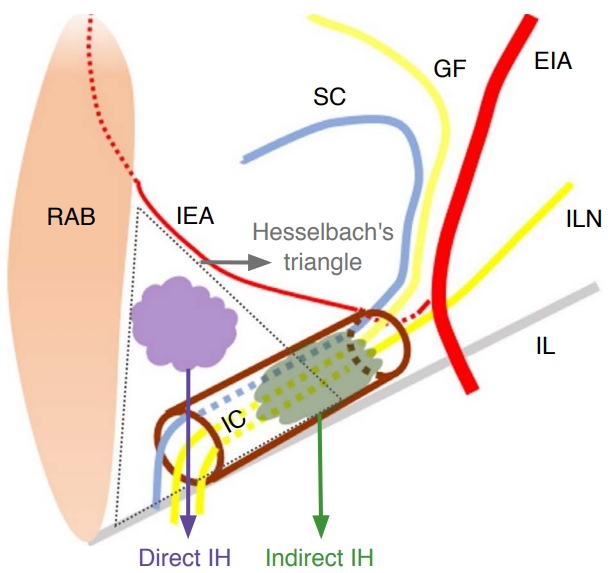 Fig. 1.Ultrasonography of the normal inguinal canal.A. The transducer is placed next to the lateral edge of the rectus abdominis muscle (RAB). B. The transducer is gradually moved from the superior-medial to inferior-lateral aspects to visualize the inferior epigastric artery (red arrows in A-C) approaching the external iliac artery (EIA). C. The transducer is then pivoted 90° to see the inguinal canal (yellow dashed region) on its short axis. D. Once the short axis of the inguinal canal is located, the transducer can be redirected parallel to the inguinal ligament to identify the inguinal canal in the long axis. White arrowheads indicate vas deferens. EAO, external abdominal oblique muscle; V, testicular vessels; F, fat.
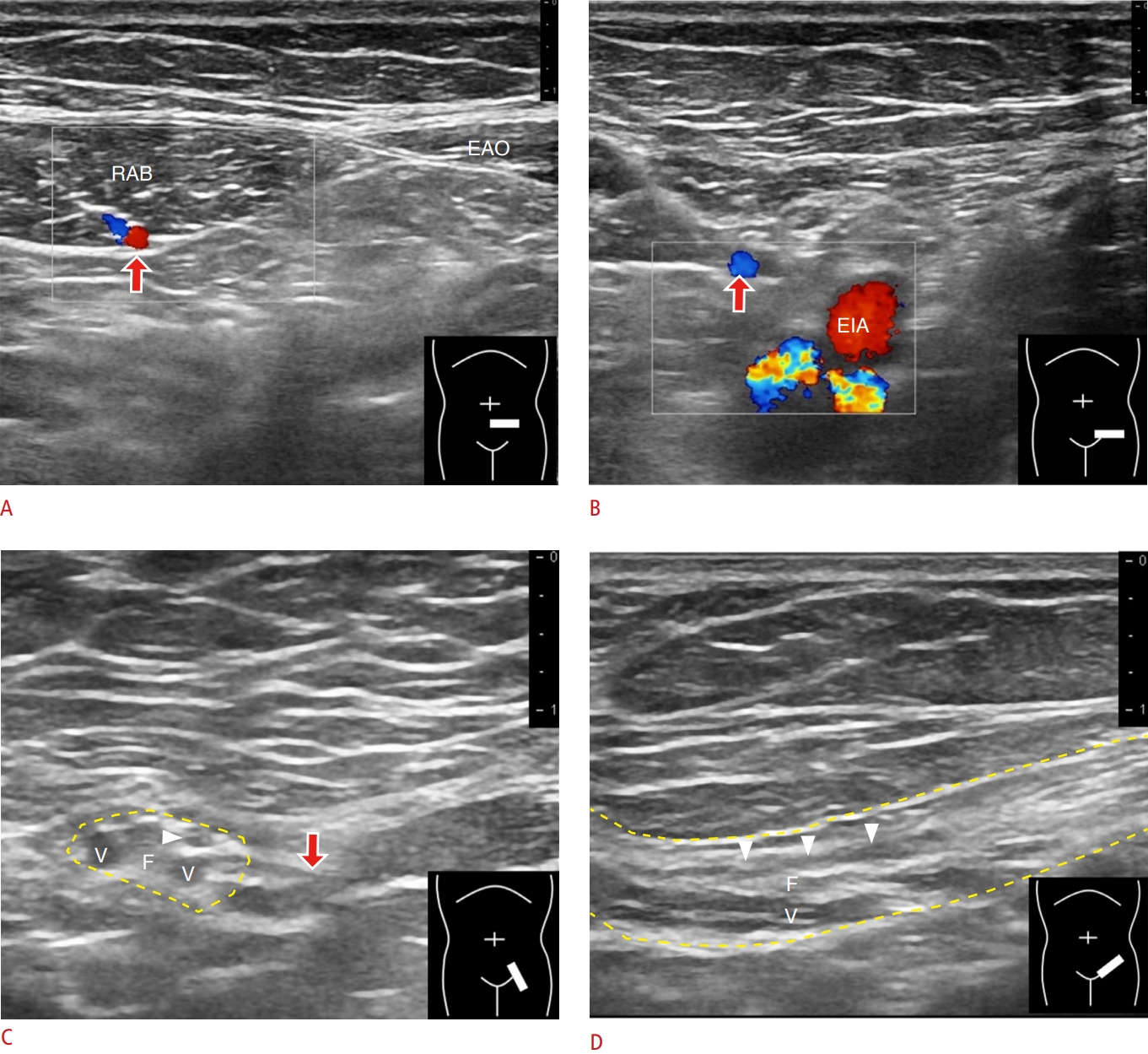 Fig. 2.Ultrasonography in a man with indirect inguinal hernia.A. The transducer was placed in the long-axis view to visualize the hernia sac, the inside of which contained peritoneal fat and bowels (asterisks in A and B). B. The transducer was placed in the short-axis view to visualize the hernia sac. White arrowheads and red arrowhead indicate spermatid cord and testicular vessel, respectively.
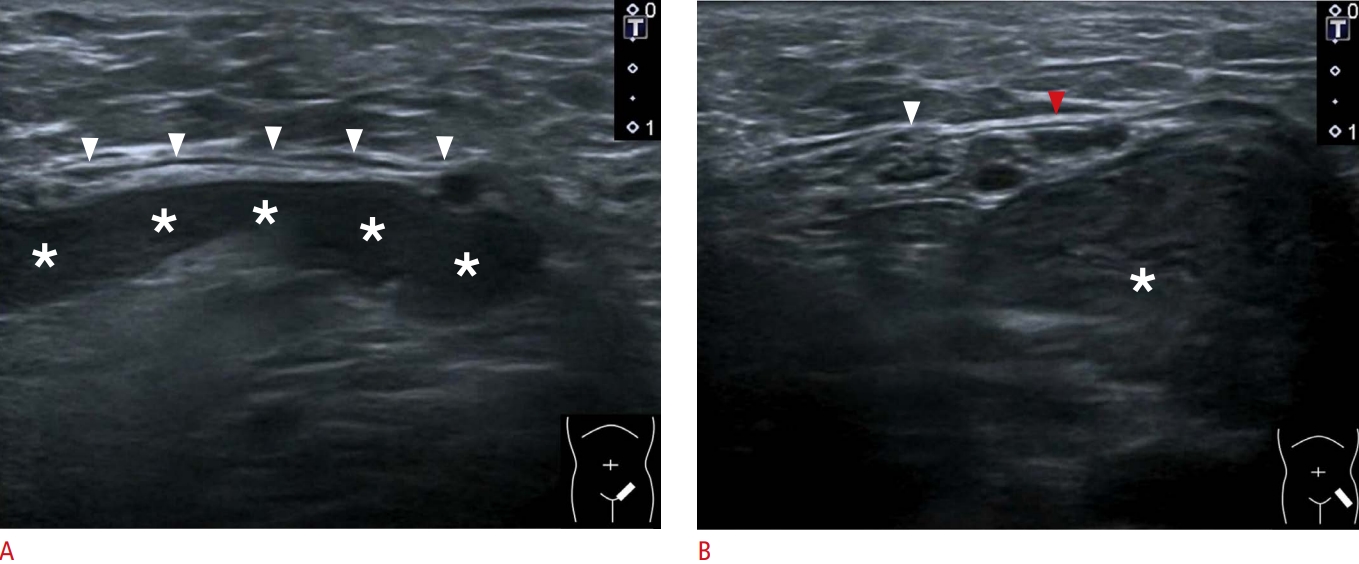 Fig. 3.Ultrasonography in another man with indirect inguinal hernia.A. The transducer was placed in the short-axis view to visualize the hernia sac, the inside of which contained peritoneal fat and bowels (asterisks in A and B). B. The transducer was placed in the long-axis view to visualize the hernia sac. The deep inguinal ring (black arrow) could be visualized at the cranial side of the hernia sac. White arrowheads indicate spermatid cord.
 Fig. 4.The Valsalva maneuver for provoking indirect inguinal hernia.A. Ultrasonography of the inguinal canal (arrowheads in A and B) was obtained in the resting supine position. B. Ultrasonography was obtained during the Valsalva maneuver, demonstrating a hernia sac with peritoneal fat and bowels (asterisks) protruding along the inguinal canal.
 Fig. 5.Ultrasonography in a woman with indirect inguinal hernia.A. Ultrasonography of the inguinal canal was obtained at the level of the deep inguinal ring. B. Ultrasonography of the inguinal canal was obtained at the middle portion of the inguinal ligament. C. Ultrasonography of the inguinal canal was obtained at its maximally dilated part. D. Ultrasonography of the inguinal canal was obtained at the superficial inguinal ring. EIA, external iliac artery. White arrowheads, round ligament; white arrows, inguinal ligament; large asterisks, hernia sac with peritoneal fat and bowel; small asterisk, fluid.
 Fig. 6.Ultrasonography of bladder hernia.Ultrasonography reveals an anechoic compressible cyst (asterisk) beside the external iliac artery (EIA), with a tract extending to the bladder (arrowhead). ILA, iliacus muscle; PUB, pubic bone.
 Fig. 7.Ultrasonography of fluid accumulation inside the canal of Nuck in a woman.A. Ultrasonography reveals a very large myoma (arrowheads). B. Ultrasonography demonstrates an accidental finding of fluid accumulation (asterisk) inside the canal of Nuck. Black arrow indicates round ligament. RAB, rectus abdominis muscle.
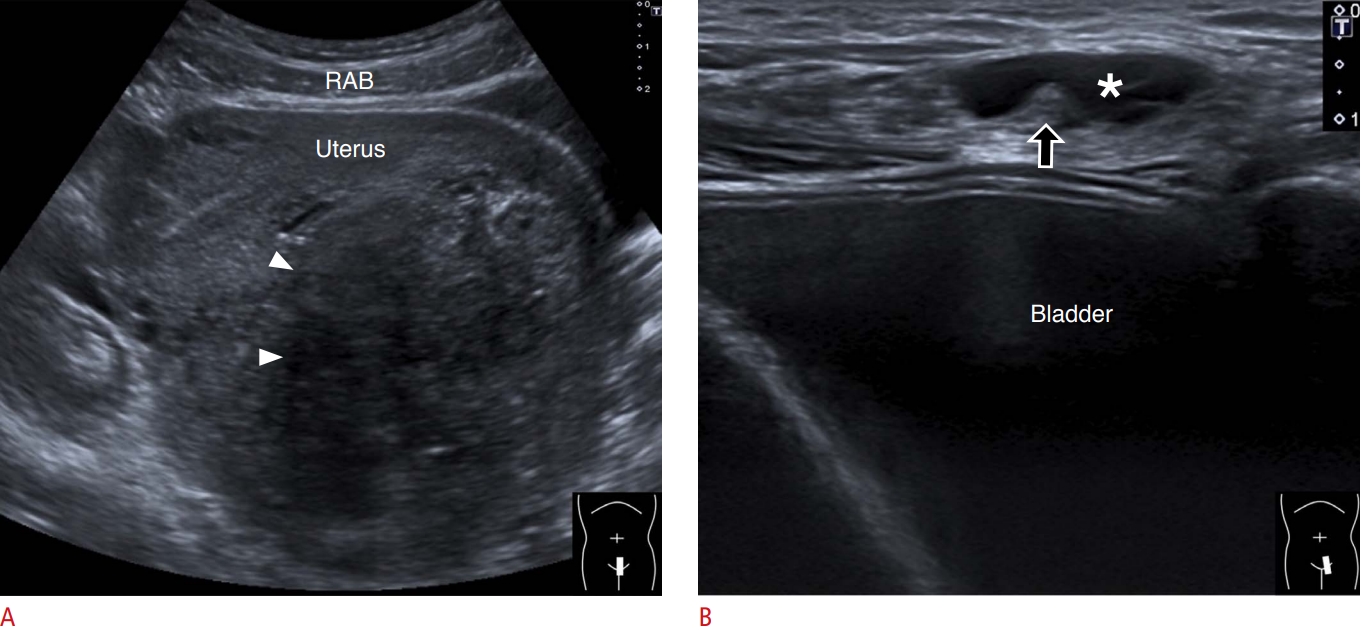 Fig. 8.Ultrasonography of a very large hydrocele in a man.Ultrasonography reveals a very large anechoic cyst (asterisks) extending thorough the inguinal canal.
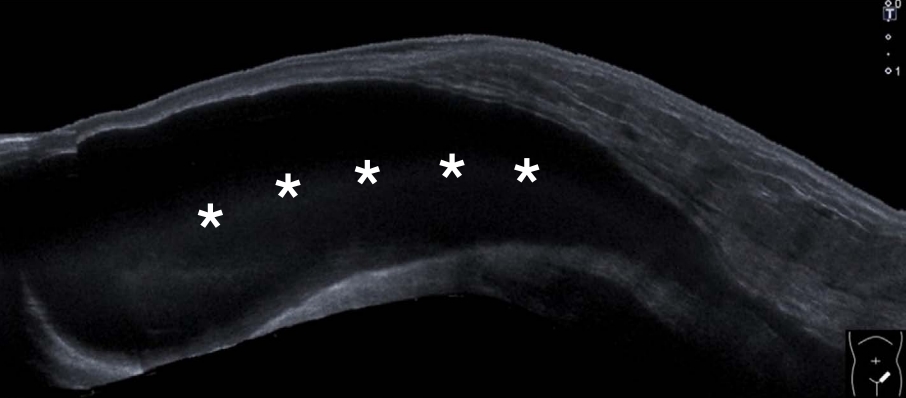 Fig. 9.Ultrasonography in a patient with direct inguinal hernia.A. Ultrasonography was obtained over Hesselbach’s triangle during the supine resting position. B. Ultrasonography was obtained over Hesselbach’s triangle during the Valsalva maneuver, showing the bowel contents protruding toward the abdominal wall. EAO, external abdominal oblique muscle; IAO, internal abdominal oblique muscle; RAB, rectus abdominis muscle. Black arrows, inferior epigastric artery; asterisks, herniation content (bowels); white arrow, indicating protrusion of the underlying bowels.
 Fig. 10.The mesh plug method for hernia repair in a male patient with indirect inguinal hernia.A. Initially, the hernia sac was identified. B. The hernia sac was separated from the spermatid cord. C. The hernia sac was reduced back to the abdominal cavity. D. A cone-shaped mesh was prepared for plugging. E. The mesh was plugged through the deep inguinal ring. F. After being plugged, the mesh was fixed on the abdominal wall. G. Finally, a patch of mesh was placed to enforce the posterior wall. The series of figures are reprinted from Huang CS (2021). In: Yeh CC, ed. NTU surgery core course [14], with permission of National Taiwan University College of Medicine.
 Fig. 11.Ultrasonography of a hematoma after a hernia repair.A. Ultrasonography was obtained over the inguinal region using the B mode, revealing a circular hypoechoic structure with multiple intralesional septa. B. Ultrasonography was obtained over the inguinal region using the power Doppler imaging, showing an increase in peripheral vascularity of the lesion. White arrows, hematoma; white arrowheads, spermatid cord.
 Fig. 12.Ultrasonography of recurrence after surgical repair for indirect inguinal hernia.A. Ultrasonography was obtained in the short-axis view of the inguinal canal. B. Ultrasonography was obtained in the long-axis view of the inguinal canal. Asterisks indicate hernia sac with peritoneal fat.
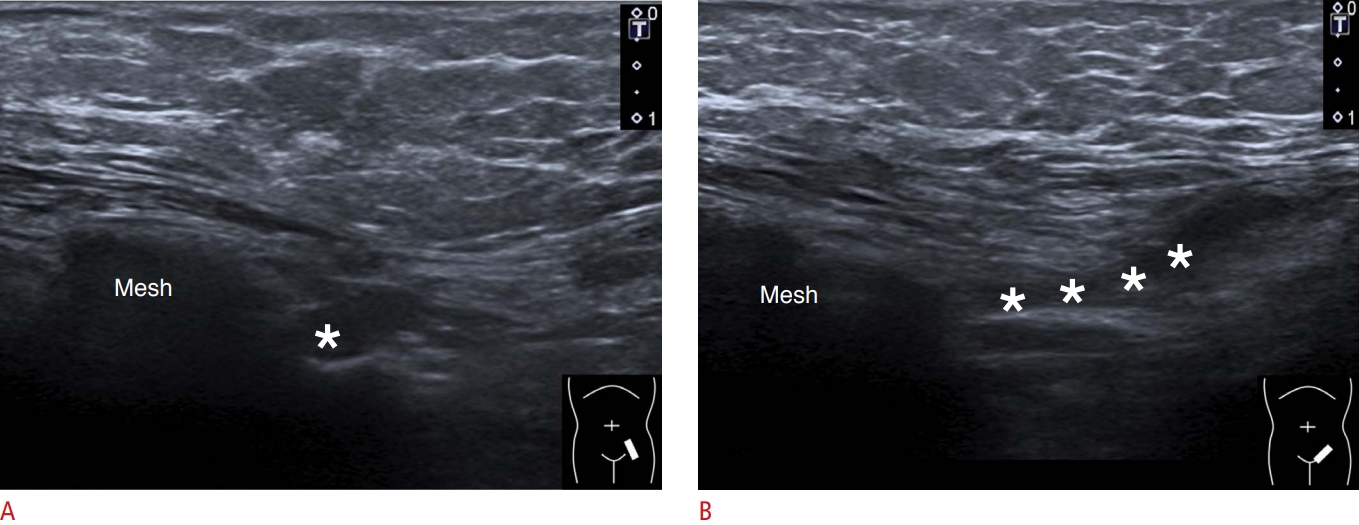 Fig. 13.Another patient with recurrence after surgical repair for indirect inguinal hernia.Ultrasonography reveals a dilated inguinal canal with presence of peritoneal fat and collapsed bowels (asterisks).
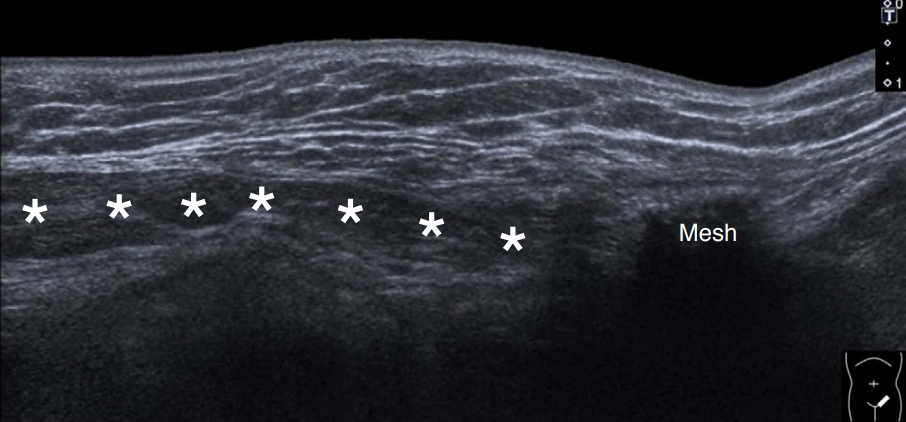 Fig. 14.Ultrasonography for recurrence in a case with direct inguinal hernia after mesh placement.A. The transducer was placed over the region where the mesh was implanted. B. Caudal to the level where the mesh was implanted, a bowel-containing hernia sac (asterisk) was visualized. RAB, rectus abdominis muscle.
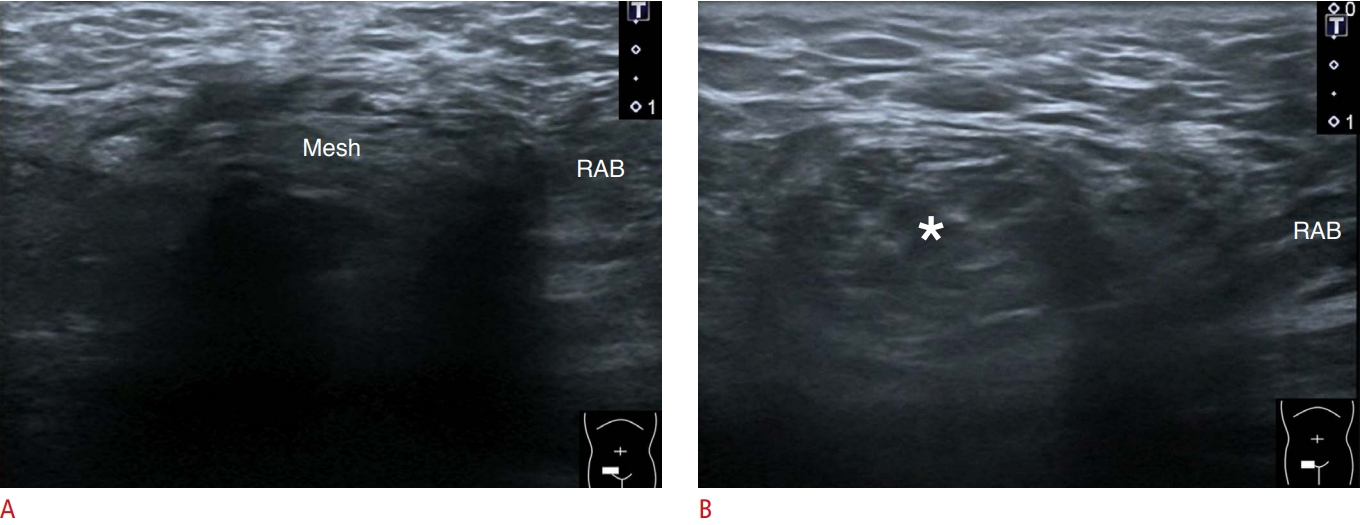 Fig. 15.Demonstration of ultrasound-guided ilioinguinal nerve block in a man.A. The ilioinguinal nerve (arrowhead in A-D) was located between the internal abdominal oblique (IAO) and transverse abdominis (TRA) muscles at the level of the iliac crest. Red arrow indicates deep iliac circumflex artery. B. The transducer was moved medially to visualize the nerve emerging toward the undersurface of the aponeurosis (black arrows) of the external abdominal oblique muscle. C. The needle was inserted from the lateral aspect of the inguinal area to target the nerve. D. The injectate was distributed surrounding the nerve. ILA, iliacus muscle.
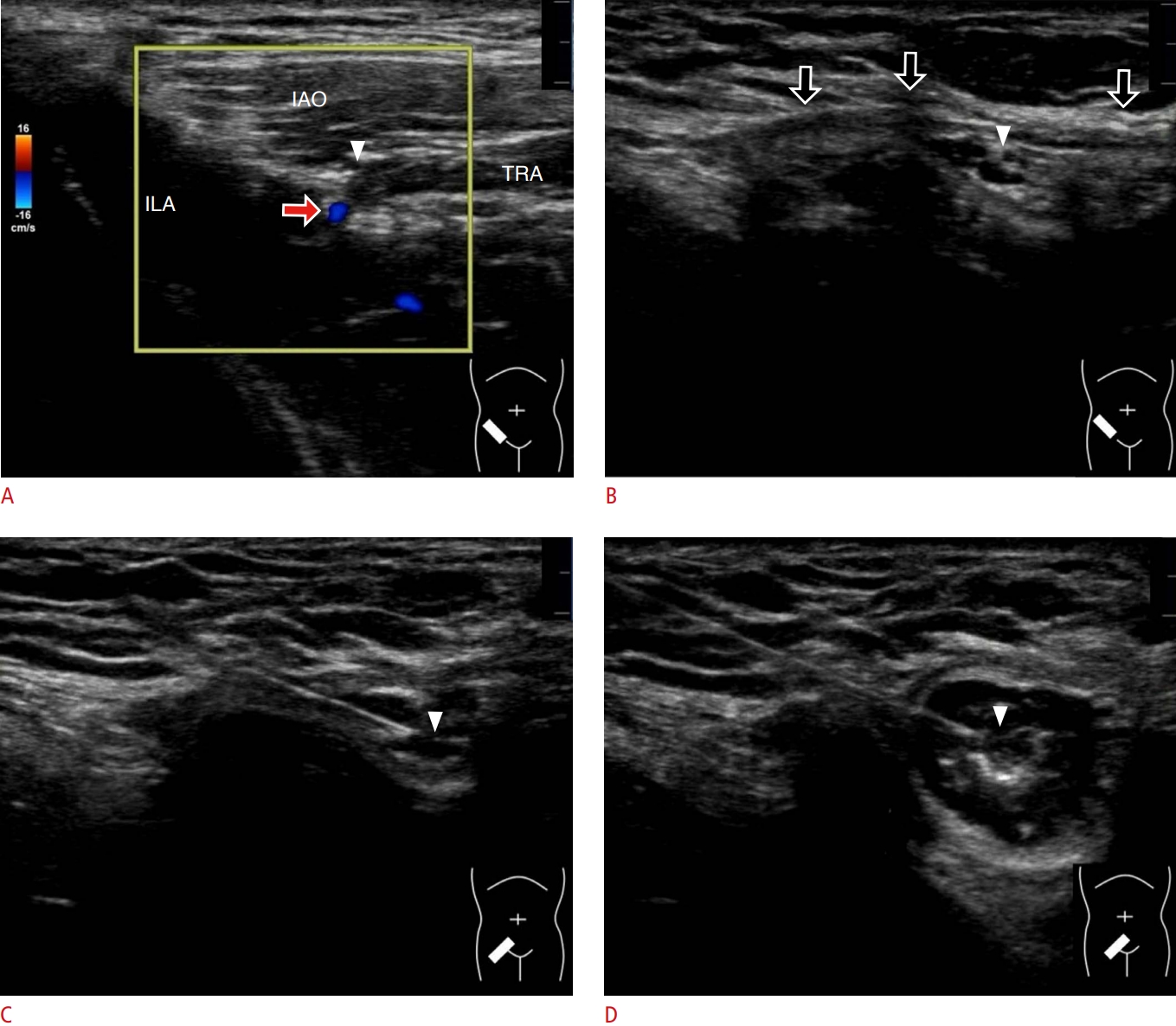 Fig. 16.Ultrasonography of common pathologies mimicking inguinal hernia.A. Ultrasonography reveals lymphadenopathy (arrow) at the inguinal region. B. Ultrasonography shows a very large lipoma (arrow) at the inguinal region. EIA, external iliac artery; SAR, sartorius muscle.
 Fig. 17.Ultrasonography of endometriosis in the inguinal region in a woman.A. The transducer was placed along the inguinal ligament (white arrows in A and B) in its long axis. B. Ectopic endometrium (arrowhead) was shown by relocating the transducer more caudally. EIA, external iliac artery; ILA, iliacus muscle; PEC, pectineus muscle.
 Fig. 18.Power Doppler ultrasonography of ectopic endometrium in a woman.The power Doppler ultrasonography reveals increased vascularity inside the ectopic endometrium (arrowhead). PEC, pectineus muscle.
 Fig. 19. |



 Print
Print facebook
facebook twitter
twitter Linkedin
Linkedin google+
google+
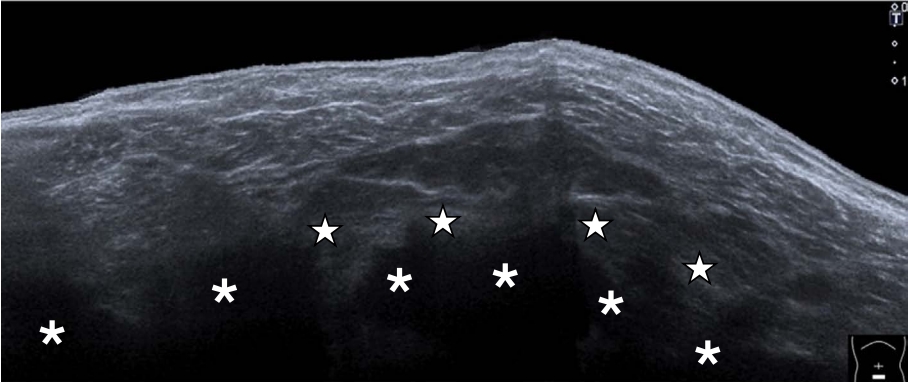
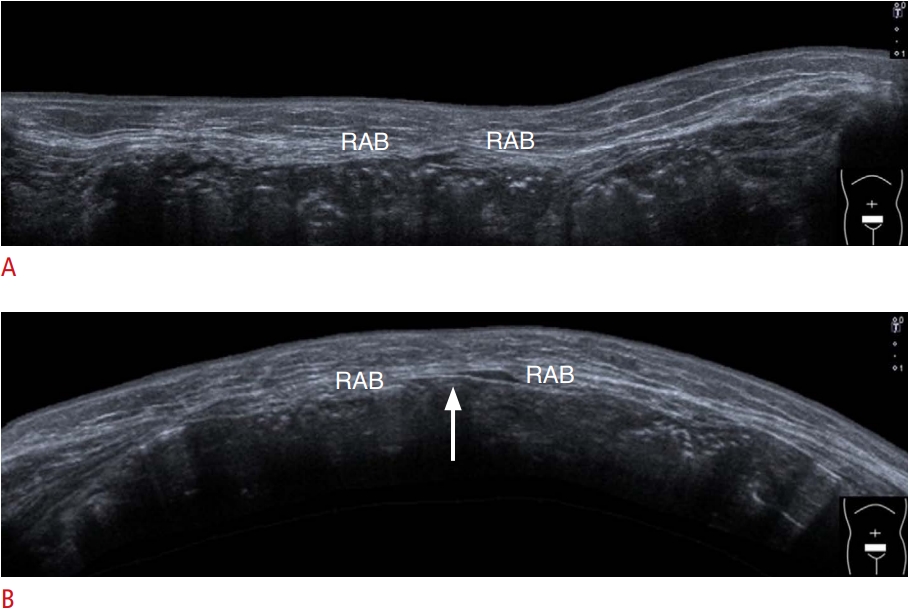
 Download Citation
Download Citation PDF Links
PDF Links PubReader
PubReader ePub Link
ePub Link Full text via DOI
Full text via DOI Full text via PMC
Full text via PMC




